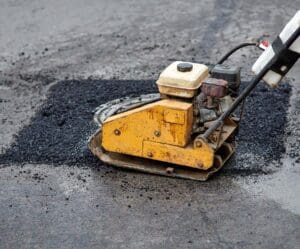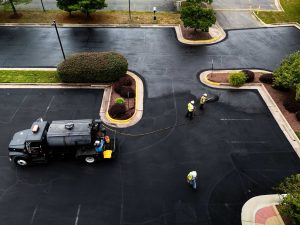Table of Contents
Asphalt is a durable and cost-effective surface for driveways, parking lots, and roadways. However, over time, asphalt faces common challenges that can compromise its appearance, functionality, and lifespan. From unsightly cracks and potholes to surface wear and environmental damage, knowing how to identify, repair, and prevent these issues is key to maintaining a smooth and safe pavement.
In this comprehensive guide, we’ll explore the most common asphalt problems, what causes them, how to fix them, and preventive measures you can take to extend the life of your pavement.
Raveling: When Asphalt Starts to Break Apart
What it is: Raveling occurs when the aggregate (small stones in the asphalt) separates from the surface, leaving a rough, worn appearance.
Causes: Over time, exposure to ultraviolet (UV) rays oxidizes the asphalt binder, which weakens the surface and allows aggregates to come loose.
How to Fix: Applying sealcoat is the most effective method to prevent raveling and protect the surface from further wear.
Prevention: Ensure a proper sealcoat is applied after new asphalt has fully cured. Regular maintenance sealcoating every few years keeps the surface protected.
Gas & Oil Stains: Protecting Your Pavement from Damage
What it is: Dark stains from spilled gasoline or oil not only look bad but can weaken the asphalt.
Causes: Leaks from vehicles, overfilling fuel tanks, or repeated spills can break down the asphalt binder.
How to Fix: For minor stains, a specialized bonding primer followed by sealcoating can restore the surface. Severe cases may require patching before sealing.
Prevention: Quickly sealcoat newly laid asphalt with a gas- and oil-resistant formula to protect against future spills.
Alligator Cracks: Pavement Stress Patterns
What it is: Named for their resemblance to alligator skin, these interconnected cracks form small, irregular blocks.
Causes: Heavy traffic, poor installation, and pavement movement create stress that leads to cracking.
How to Fix: Patching the affected areas and sealing cracks is the standard repair method.
Prevention: Proper installation, routine crack filling, and timely sealcoating reduce the risk of alligator cracking.
Potholes: The Dangers of Surface Depressions
What it is: Bowl-shaped holes of various sizes that can cause damage to vehicles and pedestrians.
Causes: Poor drainage, insufficient asphalt thickness, and neglected maintenance.
How to Fix: Full-depth patching is required for durable repairs.
Prevention: Ensure proper construction and perform timely crack sealing and sealcoating.

Polished Aggregate: Slippery Surfaces
What it is: Smooth, polished asphalt that becomes slick and unsafe under traffic.
Causes: Repeated vehicle traffic gradually polishes the aggregate, reducing traction.
How to Fix: Use a bonding primer to restore adhesion before applying sealcoat.
Prevention: Regular sealcoating helps maintain the rough texture of the asphalt surface.
Shrinkage Cracks: Large, Irregular Patterns
What it is: Interconnected cracks forming irregular blocks, often with sharp corners.
Causes: Oxidation of asphalt leads to shrinkage and loss of flexibility.
How to Fix: Seal the cracks and apply sealcoat to restore surface integrity.
Prevention: Sealcoat new asphalt after it has cured to prevent shrinkage cracks from developing.
Grade Depressions: Low Spots with Standing Water
What it is: Small, localized low areas where water tends to accumulate.
Causes: Heavy traffic or subsurface drainage problems.
How to Fix: Repair depends on inspection—either correct drainage issues or level the pavement locally.
Prevention: Proper pavement design and construction focusing on traffic load and drainage.
Longitudinal Cracks: Straight, Parallel Lines
What it is: Cracks that appear evenly spaced and parallel to paving lanes.
Causes: Weak joints between lanes or extreme temperature changes.
How to Fix: Seal the cracks promptly to prevent water infiltration.
Prevention: Use highly rubberized sealers during routine sealcoating.
Corrugation & Rutting: Uneven Pavement Surfaces
What it is: Wavy or rutted patterns in asphalt caused by heavy traffic and instability in layers.
Causes: Insufficient stability in the asphalt layers or poor compaction.
How to Fix: Remove and replace the affected pavement section.
Prevention: Ensure proper construction, compaction, and quality materials during installation.
Reflection Cracks: Cracks from Underlying Pavement
What it is: Surface cracks that appear after an overlay due to movement beneath the asphalt layer.
Causes: Movement in the underlying pavement transfers stress to the new surface.
How to Fix: Seal cracks to prevent further deterioration.
Prevention: Use pavement reinforcing fabrics prior to resurfacing to reduce crack transfer.
Why Regular Asphalt Maintenance Matters
Proper maintenance is crucial to extending the life of your asphalt. Regular inspections, timely crack repairs, sealcoating, and addressing drainage issues can prevent small problems from turning into costly repairs. A well-maintained asphalt surface improves safety, appearance, and value for residential or commercial properties.
Keep Your Asphalt Smooth and Safe With Dominion Paving
Don’t let cracks, potholes, or stains compromise your pavement. Dominion Paving offers expert asphalt repair, sealcoating, and maintenance services tailored to your property.
Contact us today to schedule an inspection and protect your asphalt investment for years to come. Your smooth, resilient pavement starts here!




